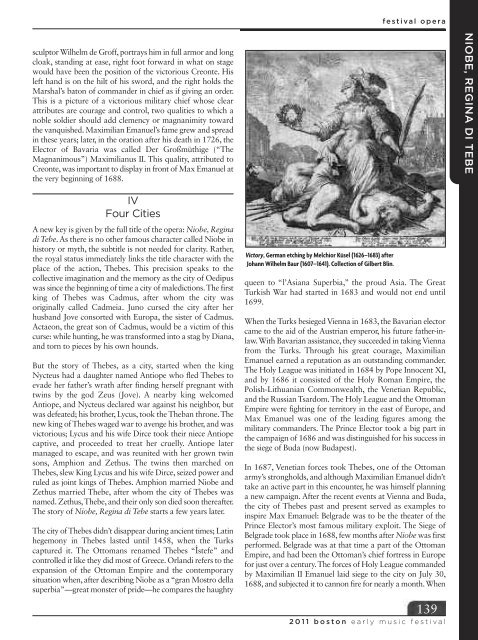Download program notes and libretto - WGBH
Download program notes and libretto - WGBH
Download program notes and libretto - WGBH
Create successful ePaper yourself
Turn your PDF publications into a flip-book with our unique Google optimized e-Paper software.
sculptor Wilhelm de Groff, portrays him in full armor <strong>and</strong> long<br />
cloak, st<strong>and</strong>ing at ease, right foot forward in what on stage<br />
would have been the position of the victorious Creonte. His<br />
left h<strong>and</strong> is on the hilt of his sword, <strong>and</strong> the right holds the<br />
Marshal’s baton of comm<strong>and</strong>er in chief as if giving an order.<br />
This is a picture of a victorious military chief whose clear<br />
attributes are courage <strong>and</strong> control, two qualities to which a<br />
noble soldier should add clemency or magnanimity toward<br />
the vanquished. Maximilian Emanuel’s fame grew <strong>and</strong> spread<br />
in these years; later, in the oration after his death in 1726, the<br />
Elector of Bavaria was called Der Großmüthige (“The<br />
Magnanimous”) Maximilianus II. This quality, attributed to<br />
Creonte, was important to display in front of Max Emanuel at<br />
the very beginning of 1688.<br />
IV<br />
Four Cities<br />
A new key is given by the full title of the opera: Niobe, Regina<br />
di Tebe. As there is no other famous character called Niobe in<br />
history or myth, the subtitle is not needed for clarity. Rather,<br />
the royal status immediately links the title character with the<br />
place of the action, Thebes. This precision speaks to the<br />
collective imagination <strong>and</strong> the memory as the city of Oedipus<br />
was since the beginning of time a city of maledictions.The first<br />
king of Thebes was Cadmus, after whom the city was<br />
originally called Cadmeia. Juno cursed the city after her<br />
husb<strong>and</strong> Jove consorted with Europa, the sister of Cadmus.<br />
Actaeon, the great son of Cadmus, would be a victim of this<br />
curse: while hunting, he was transformed into a stag by Diana,<br />
<strong>and</strong> torn to pieces by his own hounds.<br />
But the story of Thebes, as a city, started when the king<br />
Nycteus had a daughter named Antiope who fled Thebes to<br />
evade her father’s wrath after finding herself pregnant with<br />
twins by the god Zeus (Jove). A nearby king welcomed<br />
Antiope, <strong>and</strong> Nycteus declared war against his neighbor, but<br />
was defeated; his brother, Lycus, took the Theban throne.The<br />
new king of Thebes waged war to avenge his brother, <strong>and</strong> was<br />
victorious; Lycus <strong>and</strong> his wife Dirce took their niece Antiope<br />
captive, <strong>and</strong> proceeded to treat her cruelly. Antiope later<br />
managed to escape, <strong>and</strong> was reunited with her grown twin<br />
sons, Amphion <strong>and</strong> Zethus. The twins then marched on<br />
Thebes, slew King Lycus <strong>and</strong> his wife Dirce, seized power <strong>and</strong><br />
ruled as joint kings of Thebes. Amphion married Niobe <strong>and</strong><br />
Zethus married Thebe, after whom the city of Thebes was<br />
named. Zethus,Thebe, <strong>and</strong> their only son died soon thereafter.<br />
The story of Niobe, Regina di Tebe starts a few years later.<br />
The city of Thebes didn’t disappear during ancient times; Latin<br />
hegemony in Thebes lasted until 1458, when the Turks<br />
captured it. The Ottomans renamed Thebes “İstefe” <strong>and</strong><br />
controlled it like they did most of Greece. Orl<strong>and</strong>i refers to the<br />
expansion of the Ottoman Empire <strong>and</strong> the contemporary<br />
situation when, after describing Niobe as a“gran Mostro della<br />
superbia”—great monster of pride—he compares the haughty<br />
Victory, German etching by Melchior Küsel (1626–1683) after<br />
Johann Wilhelm Baur (1607–1641). Collection of Gilbert Blin.<br />
f e s t i va l o p e ra<br />
queen to “l’Asiana Superbia,” the proud Asia. The Great<br />
Turkish War had started in 1683 <strong>and</strong> would not end until<br />
1699.<br />
When the Turks besieged Vienna in 1683, the Bavarian elector<br />
came to the aid of the Austrian emperor, his future father-inlaw.With<br />
Bavarian assistance, they succeeded in taking Vienna<br />
from the Turks. Through his great courage, Maximilian<br />
Emanuel earned a reputation as an outst<strong>and</strong>ing comm<strong>and</strong>er.<br />
The Holy League was initiated in 1684 by Pope Innocent XI,<br />
<strong>and</strong> by 1686 it consisted of the Holy Roman Empire, the<br />
Polish-Lithuanian Commonwealth, the Venetian Republic,<br />
<strong>and</strong> the Russian Tsardom.The Holy League <strong>and</strong> the Ottoman<br />
Empire were fighting for territory in the east of Europe, <strong>and</strong><br />
Max Emanuel was one of the leading figures among the<br />
military comm<strong>and</strong>ers. The Prince Elector took a big part in<br />
the campaign of 1686 <strong>and</strong> was distinguished for his success in<br />
the siege of Buda (now Budapest).<br />
In 1687, Venetian forces took Thebes, one of the Ottoman<br />
army’s strongholds, <strong>and</strong> although Maximilian Emanuel didn’t<br />
take an active part in this encounter, he was himself planning<br />
a new campaign. After the recent events at Vienna <strong>and</strong> Buda,<br />
the city of Thebes past <strong>and</strong> present served as examples to<br />
inspire Max Emanuel: Belgrade was to be the theater of the<br />
Prince Elector’s most famous military exploit. The Siege of<br />
Belgrade took place in 1688, few months after Niobe was first<br />
performed. Belgrade was at that time a part of the Ottoman<br />
Empire, <strong>and</strong> had been the Ottoman’s chief fortress in Europe<br />
for just over a century.The forces of Holy League comm<strong>and</strong>ed<br />
by Maximilian II Emanuel laid siege to the city on July 30,<br />
1688, <strong>and</strong> subjected it to cannon fire for nearly a month.When<br />
139<br />
2 0 1 1 b o s t o n e a r l y m u s i c f e s t i v a l<br />
NIOBE, REGINA DI TEBE


















